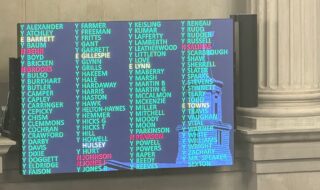May 12, 2025
Proposal impacts nearly every workplace, indoors and outside, in Vermont
Worker safety is a priority for small businesses. Maintaining a safe environment is critical for worker satisfaction and retention, controlling workers’ comp and other employment costs, and for ensuring quality work.
For small business owners, safety is also personal since workers are often family, friends, or co-owners.
Unfortunately, Vermont lawmakers are considering a proposal to impose strict workplace temperature regulations on a wide range of employers in the state (S.153, H.348).
Under the threat of a lawsuit by a worker, the proposal requires small employers to make complex judgments about supplies, weather, worksite conditions, medical conditions, training, and more. The regulations would apply to indoor and outdoor worksites, and during hot and cold periods.
Worried about getting sued when it’s hot or cold? Click here to TAKE ACTION today!
Check out NFIB’s guide to Protecting Your Workers from the Heat.
What’s Required: The Vermont proposal imposes the following planning and education requirements:
1) Workplace Thermometer. Employers must display a thermometer at each indoor and outdoor worksite and in work vehicles. The thermometer must be capable of measuring the “wet bulb globe temperature.”
2) Prevention Plan. All employers must develop a written extreme injury and illness prevention plan with work-site specific information, including list of work activities covered and factors that could increase the likelihood of injury or illness; a plan for compliance with the requirements of this legislation; information on education and training; and emergency response procedures.
The plan must be updated annually, whenever there is a change to work conditions, or when there is a temperature-related work incident.
3) Response Plan. Employers must also prepare a detailed emergency response plan and have procedures to relieve, monitor, and offer first aid to employees experiencing signs of illness or injury. Employers must take immediate action to reduce the employee’s body temperature in a heat emergency or increase body temperature in a cold emergency.
4) Education and Training. Employers must provide education and training at no cost that covers information about and risk factors for temperature-related illnesses and injuries; the importance of proper equipment, taking breaks, staying hydrated, and reporting symptoms; location of break areas and water; the employer’s plan and how to access the plan; and the right to protection from retaliation.
Training must be provided to new employees upon hire and all employees annually, as well as when job duties change, the employer’s policies change, or there’s a heat wave or “significant drop” in temperature expected. Supervisors must be appropriately trained. Training must be provided in a language and literacy level that each employee understands.
Heat Injury and Illness Prevention. When the temperature exceeds 80 degrees, employers must provide:
– an effective means of communication for employees to contact a supervisor to address concerns about the temperature
– access to potable drinking water that is “readily accessible,” “suitably cool,” and “of sufficient quantity to provide access to one quart of drinking water per employee per hour.”
– when working outdoors, an area for all employees can take a break that includes natural or artificial shade, or air conditioning in a vehicle, building, or trailer
– when working indoors, a readily accessible break area that is air conditioned or has “increased air movement” and “if appropriate, dehumidification”
Employers must encourage employees to request preventative cool down breaks “of not less than ten minutes as needed,” monitor employees for symptoms of heat illness and heat emergency, and provide first aid or emergency response as needed.
Other requirements include ensuring proper functioning of equipment intended to cool employees, ensuring that work vehicles have functioning air condition (unclear if this applies to personal vehicles, work vehicles, or both), and an “acclimatization protocol” to gradually introduce new hires and workers returning from an absence longer than 14 days to temperatures above 80 degrees.
Additional mandatory rest requirements apply when the temperature reaches 90 degrees and 100 degrees, including monitoring via a “buddy system in which co-workers observe each other,” observation by a supervisor (no more than 1 supervisor: 20 employees), or effective two-way communication with solo employees.
Cold Illness Injury and Prevention. The cold plan imposes similar requirements as the heat plan but with variations intended for temperatures below 60 degrees.
This includes things like ensuring outdoor workers can take breaks in a “warm and draft-free setting,” have access to warm beverages, can change out of wet clothes, and have access to heated vehicles.
When the temperature falls below 40 degrees and 30 degrees, additional specific requirements kick in, such as: a minimum 15 minute rest break every two hours; dry replacement clothes; and personal protective equipment for the employee’s ears, face, hands, and feet.
Enforcement: Employees are guaranteed protection from retaliation for exercising their rights under the proposal. Employees can sue employers for violations of the proposal’s requirements.
Exemptions. The proposed regulation exempts:
(i) work activities where there is “no reasonable expectation” of exposure to temperatures below 60 degrees or above 80 degrees
(ii) work environments where employees are exposed to temperatures below 60 degrees or above 80 degrees for 15 minutes or less in any 60-minute period
(iii) work activities performed indoors or in vehicles where heating and air conditioning systems consistently keep the “ambient temperature” between 60 and 80 degrees
(iv) firefighting or emergency response covered by state or federal regulation
(v) work performed from home or a place of the employee’s choosing
(vi) “sedentary work activities at indoor work areas that only involve 4 some combination of the following: sitting, occasional standing and walking 5 for brief periods or time, and occasional lifting of objects weighing less than 6 10 pounds”
As written, employment would have to satisfy all six conditions to the exempt. Further, it’s unclear how an employer or manager could claim an exemption under (ii) without constantly monitoring the employee with a stop watch.
The bill appears to exempt an employer in their entirety from these regulations if all employees meet the criteria above. However, again, all employees would have to meet all six criteria as the bill is currently written.
Nationwide Temperature Regulation Push: Lawmakers and regulators across the country are increasingly seeking to override common sense with complicated, inflexible and one-size-fits-all mandates.
In 2024, the Biden Administration proposed the Heat Injury and Illness Prevention (HIIP) OSHA rule. The Trump Administration ordered a freeze on all pending OSHA rules earlier this year, and the HIIP rule has not been finalized.
NFIB opposed HIIP on the grounds that it exceeded OSHA’s authority, was ill-suited to small employers, and would require the hiring of costly outside human resources, safety, and legal consultants for work that was already being done by most small businesses.
NFIB’s comments reference feedback provided to OSHA by a Small Business Advocacy Review Panel established to review HIIP:
Many SERs felt that a standard is unnecessary because there are existing incentives that cause employers to implement heat-related protections at their workplace. Several SERs shared that they are facing a tight labor market and will lose employees to their competitors if they don’t provide them with a safe workplace—this incentivizes employers to take workplace health and safety seriously, making a heat standard unnecessary. One of these SERs said that if an employer does not take their workers’ safety and health seriously, employees will quit or complain on social media or employer review sites which would hurt the employer’s ability to hire people. A few SERs told the Panel that their workers’ compensation system creates an incentive to keep their workers safe from all hazards including heat injury and illness.
In January 2025, the U.S. Small Business Administration also weighed in on HIIP with concerns the burden placed on small employers:
“OSHA has not provided exceptions to the mandatory (high heat trigger) rest break provisions (i.e., 15 minutes every two hours) where materials like asphalt and concrete are time-sensitive and must be applied upon delivery. Further, requiring inflexible break schedules can create a greater hazard in industries like tree care and telecommunications tower erection and maintenance, where climbing up and down from heights is the primary safety concern and can introduce a greater hazard to employee safety. Finally, requiring artificial shade and temporary structures may be infeasible in operations such as road construction, where vehicular traffic and the rapidly changing work environment can introduce greater hazards.”
SBA’s comments also highlighted the regulation’s requirement that small employers provide training on and make complex medical decisions; that heat temperature triggers were too low and should not start until 90 or 100 degrees; and that small employers with fewer than 50 employees should be exempt from the written planning portions of the rule.
Concerned about one-size-fits-all temperature regulations?
Worried about getting sued when it’s hot or cold? Click here to TAKE ACTION today!
NFIB is a member-driven organization advocating on behalf of small and independent businesses nationwide.
Related Articles














